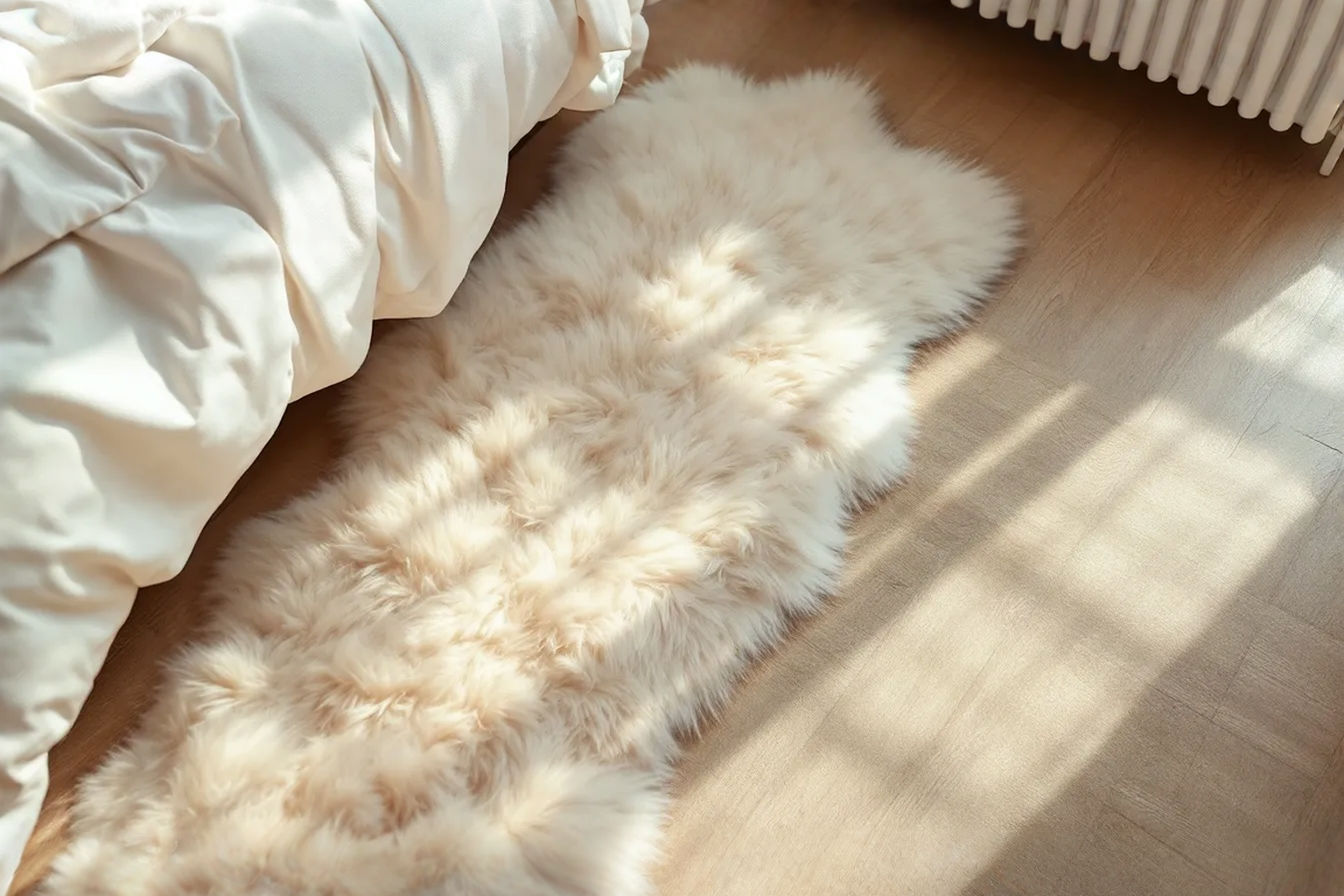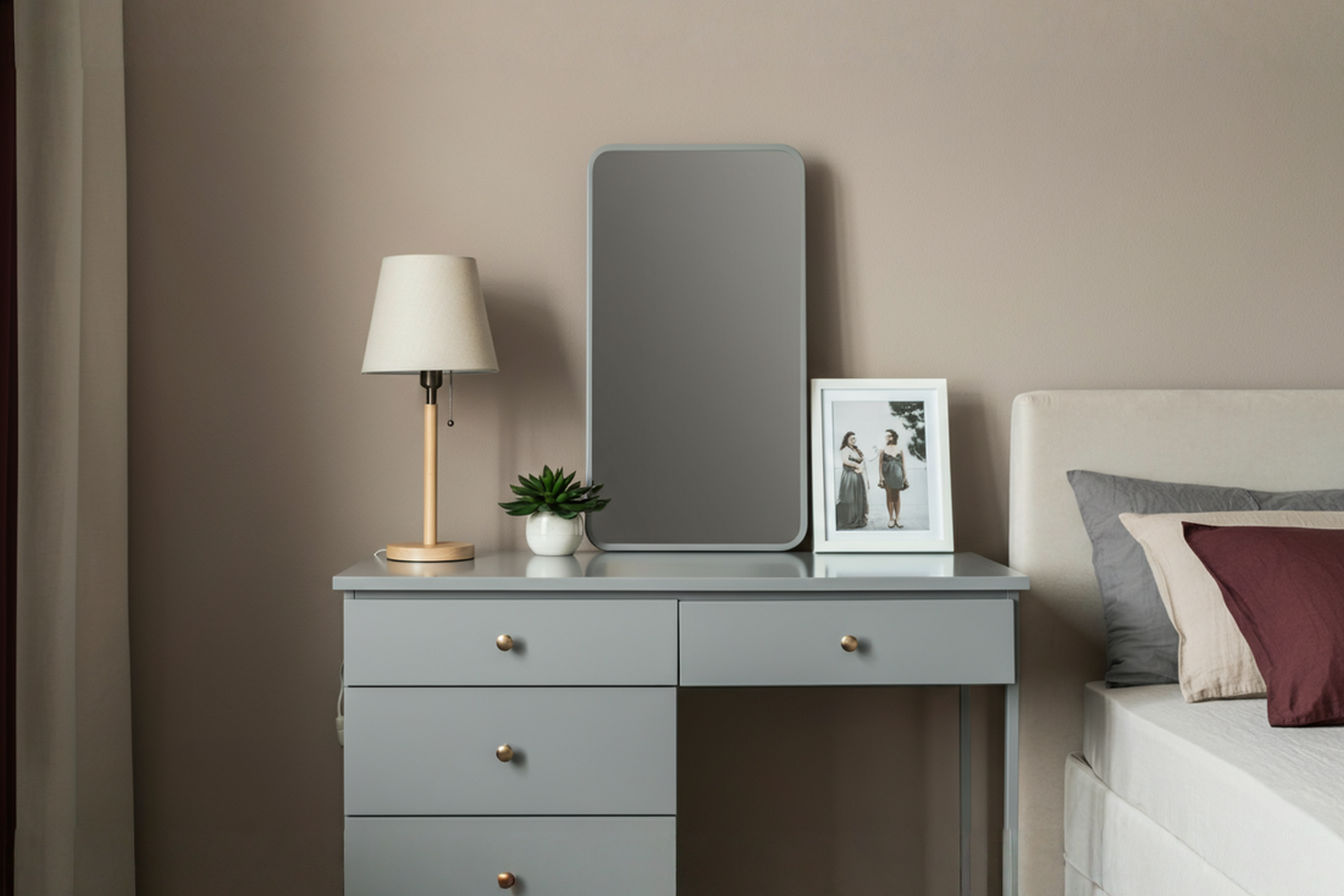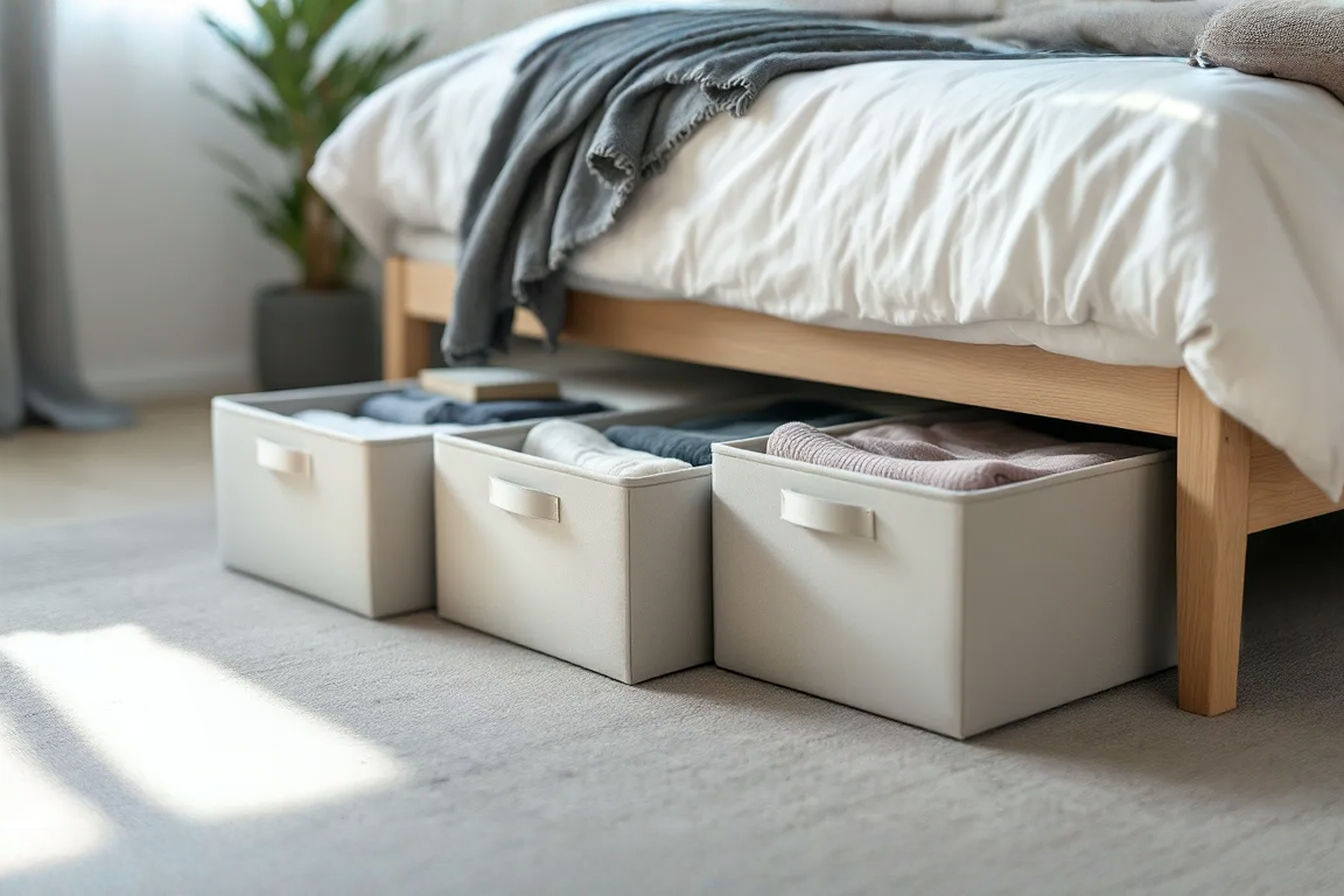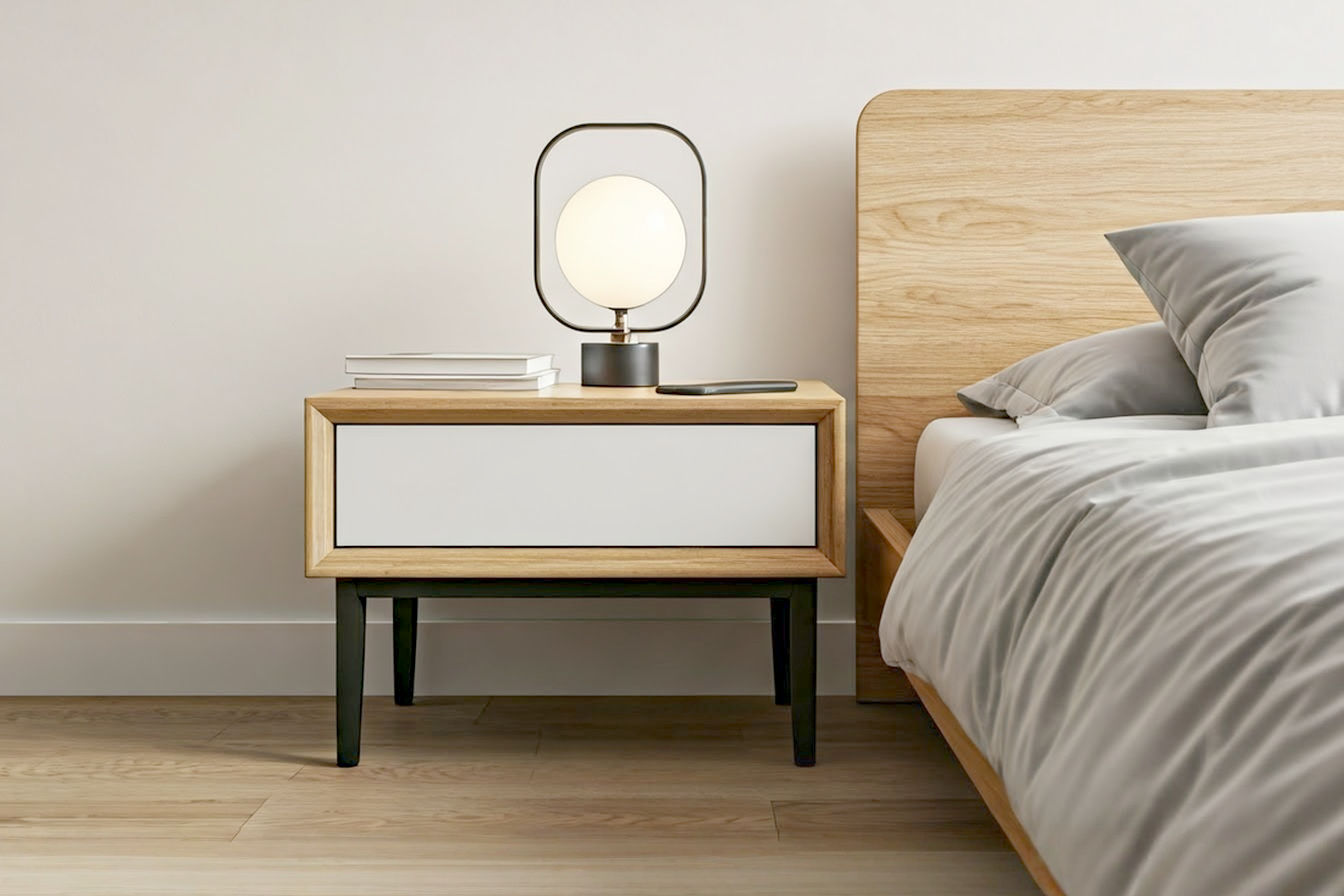Fur Carpet for Bedroom: Cozy Trend or Cleaning Nightmare?
Plush, soft, and luxurious – fur carpets promise a cozy bedroom. But are they easy to keep clean? Discover the truth about these trendy rugs…

This post may contain affiliate links. If you make a purchase through these links, we may earn a commission at no additional cost to you.
Imagine stepping out of bed onto a cloud of softness. That’s the dream a fur carpet or rug in the bedroom promises. These plush floor coverings have become incredibly popular, adding a touch of luxury, warmth, and undeniable coziness to private spaces. They look fantastic in design magazines and on social media, creating an inviting, serene atmosphere. But while the aesthetic appeal is clear, there’s a practical question many people ponder before buying: are they a cleaning nightmare?
This isn’t a simple yes or no answer. The reality is that while they offer significant comfort and style benefits, maintaining a fur or high-pile rug does require more effort than a standard low-pile carpet. They can trap dust, dirt, and allergens more easily, and spills can be tricky to handle. Deciding if a fur carpet for your bedroom is the right choice means weighing the luxurious feel against the commitment to keeping it clean and beautiful. We’ll explore both sides in detail, helping you understand the allure, the different types available, the specific cleaning challenges they present, and the most effective ways to keep them looking their best. By the end, you’ll have a clear picture of whether this cozy trend fits into your lifestyle or if it’s a maintenance challenge you’d rather avoid.
The Allure of the Fur Carpet: Why Cozy Wins Hearts
There’s something uniquely appealing about a soft, fluffy rug in a bedroom. It transforms the space, making it feel more intimate, comfortable, and luxurious. This isn’t just about looks; it’s a sensory experience that contributes significantly to the room’s overall ambiance.
Softness and Texture: The Tactile Appeal
The most immediate draw of a fur or high-pile rug is its incredible softness. Stepping onto one with bare feet provides a sensation of warmth and comfort that hard flooring or short-pile carpets just can’t match. This tactile quality is especially desirable in a bedroom, a space dedicated to relaxation and rest. The deep pile or soft fibers create a cushioned surface that feels gentle underfoot, perfect for those first steps in the morning or the last ones at night. This plush texture invites you to sink your toes in, enhancing the feeling of being in a personal sanctuary.
Visual Warmth and Style: Enhancing Bedroom Decor
Beyond the feel, faux fur rugs and sheepskin rugs bring significant visual warmth to a room. Their fluffy texture adds a layer of visual softness, making hard furniture and clean lines feel less stark. They can soften the look of wooden floors or add contrast to existing carpeting. Available in a wide range of colors, shapes, and sizes, from classic white sheepskins to vibrant colored faux furs and large shaggy area rugs, they can complement almost any decor style, from minimalist modern to rustic or bohemian. A well-placed bedroom rug can anchor a seating area, define the space around a bed, or simply add a pop of texture and color. They contribute to a layered look that feels rich and inviting.
Creating a Sanctuary: The Feeling of Luxury and Comfort
Ultimately, a cozy bedroom rug helps create a feeling of a personal retreat. The softness underfoot, the visual appeal, and the sense of warmth all contribute to making the bedroom feel like a truly comfortable and safe space. It’s about creating an environment where you can relax, unwind, and feel pampered. This sense of luxury doesn’t necessarily come with a high price tag, especially with the wide availability of high-quality faux options, making the cozy bedroom trend accessible to many.
Popular Styles and Materials: A Quick Look
When people talk about “fur carpets” for the bedroom, they usually mean one of a few popular styles:
- Faux Fur Rugs: Made from synthetic materials designed to mimic the look and feel of real animal fur. They come in various lengths, densities, and colors, often resembling sheepskin, bear, or other animal hides.
- Genuine Sheepskin Rugs: Made from the treated hide and fleece of sheep. These are natural products known for their unique texture, durability, and natural properties.
- Shaggy Rugs: Characterized by a deep, long pile. While not always made to look like animal fur, their long fibers create a similar fluffy, cozy effect. They can be made from wool or synthetic materials.
Each type has its own characteristics, which significantly impact both its aesthetic contribution and, crucially, its cleaning requirements. Understanding these differences is key to managing expectations and choosing the right rug for your space and lifestyle.
Beyond the Fluff: Understanding Different ‘Fur’ Types
While they all offer a similar promise of softness and warmth, the world of fur carpets for the bedroom encompasses different materials, each with its own properties, advantages, and disadvantages, particularly when it comes to cleaning and maintenance. Let’s look closer at the most common types you’ll encounter.
Faux Fur: The Ethical and Accessible Option
Faux fur, also known as fake fur, is a textile material designed to imitate the appearance and texture of animal fur. It gained popularity as an ethical alternative to real fur and is widely used in clothing, throws, and, of course, rugs.
Materials and Manufacturing
Faux fur is typically made from synthetic polymeric fibers such as polyester, acrylic, and modacrylic. These fibers are manufactured through chemical processes. The production often involves weaving or knitting these fibers into a fabric backing, and then the fibers are cut and sometimes treated to give them a soft, fluffy, or textured finish that looks like real fur. The length and density of the fibers can be varied significantly during manufacturing to mimic different animal furs, from short and dense to long and shaggy.
Pros of Faux Fur Rugs
One of the biggest advantages is cost. Faux fur rugs are generally much more affordable than genuine animal hides. They are also cruelty-free, appealing to those who prefer not to use animal products. From a practical standpoint, many faux fur rugs are designed to be hypoallergenic, as they don’t contain the natural animal dander that can trigger allergies in some people. They also come in an almost endless variety of colors and patterns, offering greater design flexibility.
Cons of Faux Fur Rugs
Despite their benefits, faux fur rugs have drawbacks. The synthetic fibers can be prone to matting and tangling, especially in high-traffic areas, losing their fluffy appearance over time. While some higher-quality faux furs shed minimally, many, particularly less expensive ones, can shed fibers, which can be annoying and contribute to dust. Cleaning can also be challenging; while some smaller faux fur rugs might be machine washable (always check the label!), larger ones often require spot cleaning or professional attention, and improper cleaning can damage the fibers, making them stiff or matted. Furthermore, the production of synthetic fibers has environmental considerations, as they are derived from petrochemicals and are not biodegradable.
Genuine Sheepskin/Animal Hide: Natural Luxury
Genuine sheepskin rugs are made from the actual hide of a sheep, with the wool fleece still attached. Other animal hides like cowhide are also used as rugs, though sheepskin is the most common “fur” type in bedrooms due to its softness and density.
Source and Tanning Process
Sheepskin is a natural byproduct of the meat industry. The hides undergo a complex tanning process to preserve the skin, make it pliable, and prevent decay. Traditional tanning methods might use chemicals like chromium salts, while more environmentally friendly methods use vegetable-based agents or synthetic alternatives. The fleece is cleaned and sometimes treated to achieve a desired texture or color, though many are sold in their natural state. This process transforms the raw hide into a durable, soft leather backing with the intact wool fleece.
Natural Properties of Wool
Wool fleece has remarkable natural properties. It’s a natural temperature regulator, meaning it can help keep you warm in the winter and cool in the summer. This is because the fibers are hollow and can trap air, providing insulation, while also being breathable and wicking away moisture. Wool also contains lanolin, a natural wax that gives it a degree of water and dirt resistance and can make it feel soft. Wool fibers are also naturally resilient and have a crimp that allows them to spring back into shape, contributing to the rug’s loft.
Pros of Genuine Sheepskin Rugs
Genuine sheepskin rugs are known for their durability when properly cared for; they can last for many years, even decades. Their natural fibers offer a unique, luxurious feel that many find superior to synthetics. They are also naturally hypoallergenic for most people, as the structure of the wool fibers is less likely to harbor dust mites compared to synthetic materials, and the lanolin can be soothing to skin. Real sheepskin is also biodegradable, making it a more environmentally friendly option at the end of its life compared to synthetic faux furs.
Cons of Genuine Sheepskin Rugs
The primary drawback of genuine sheepskin is cost; they are significantly more expensive than faux fur alternatives. They require specific cleaning methods to avoid damaging the leather hide, which can become stiff or crack if exposed to too much heat or harsh chemicals. While wool has some natural stain resistance, spills need to be dealt with quickly. Real sheepskin can also have a natural odor, especially when new, which usually fades over time. While the fibers are well-anchored in the hide, some minimal shedding can still occur.
Shaggy Rugs (High Pile): The Texture King
Shaggy rugs are defined by their long pile fibers, typically an inch or more in length. They create a wonderfully soft and informal look, making them a popular choice for bedrooms and living areas where comfort is key.
Materials and Construction
Shaggy rugs can be made from a variety of materials, both natural and synthetic. Common materials include wool, polyester, polypropylene, and acrylic. The construction is often tufted, where yarns are punched through a fabric backing, or sometimes woven. The key characteristic is the length and looseness of the pile, which gives them their distinctive shaggy appearance and soft feel. The density of the pile can vary, affecting how plush and how challenging they are to clean.
Pros of Shaggy Rugs
The main appeal of shaggy rugs is their extreme coziness and softness. They provide excellent insulation and can help with sound absorption in a room, making the bedroom feel quieter and more peaceful. They come in a vast array of colors, patterns, and fiber types, offering extensive design options. Synthetic shaggy rugs, particularly those made from polypropylene, can be relatively stain-resistant and more affordable than wool or genuine sheepskin.
Cons of Shaggy Rugs
The long pile of shaggy rugs is a magnet for dirt, dust, crumbs, and pet hair. These particles can easily get trapped deep within the fibers, making regular cleaning essential and sometimes difficult. Like faux fur, shaggy rugs, especially synthetic ones, are prone to matting and tangling, losing their fluffy appearance in high-traffic spots. Spills are particularly problematic as liquids can quickly soak into the backing. The weight and bulk of larger shaggy rugs can also make them difficult to move for cleaning or shaking outside.
Understanding these material differences is the first step in managing the “cleaning nightmare.” Each type requires a slightly different approach to maintenance and cleaning to preserve its beauty and longevity.
The Flip Side: Why Cleaning Feels Like a Nightmare
So, you’ve been captivated by the cozy appeal and perhaps chosen a beautiful faux fur rug or a luxurious sheepskin rug for your bedroom. Now comes the reality of keeping it clean in a space where we shed skin cells, dust accumulates, and the occasional spill is inevitable. The very features that make these rugs so comfortable and visually appealing are often what make them challenging to clean.
Trapping Dust, Dirt, and Allergens: The Nature of the Fibers
The long, dense fibers or deep pile of fur and shaggy rugs are incredibly effective at trapping airborne particles. Dust, dirt tracked in from other rooms, lint, and pet dander (if you have furry friends) settle deep within the rug’s structure. Unlike low-pile carpets where debris sits closer to the surface, the length of the fibers in a shaggy or fur rug allows these particles to work their way down to the backing, making them harder to remove with just a quick vacuum. This trapped debris isn’t just unsightly; it can also be a significant source of allergens, potentially impacting air quality in the bedroom, a space where you spend many hours.
Dealing with Spills and Stains: A Race Against Time
Liquid spills on a fur or shaggy rug are particularly problematic. The open structure of the pile allows liquids to quickly penetrate deep into the fibers and reach the backing material. Once a liquid, especially something colored like coffee or juice, soaks in, it can spread and stain the fibers and potentially the backing. The density of the pile also makes it difficult to effectively blot up the liquid before it penetrates. Rubbing a spill, a natural first instinct, only pushes the liquid deeper and can damage the fibers, causing matting or spreading the stain. Dealing with spills requires immediate action and careful technique to prevent permanent damage.
Matting and Tangling: Loss of Texture and Appearance
One of the most common complaints about fur and shaggy rugs is that they can mat and tangle over time. This is especially true for synthetic faux fur and shaggy rugs. The fibers, subjected to foot traffic or even just gravity and friction, can become compressed and intertwined. This matting causes the rug to lose its fluffy, plush appearance, looking flat and worn in certain areas. Tangling makes the fibers stick together, further detracting from the soft texture. Restoring the original loft and separating tangled fibers can be a time-consuming process, often requiring specific tools like a rug rake or a wide-toothed comb.
Odor Absorption: How Fibers Hold Smells
Textile fibers, particularly natural ones like wool, can absorb odors from their environment. In a bedroom, this could include body odors, pet smells, or even cooking odors that drift in. The dense structure of fur and shaggy rugs means there’s a large surface area of fiber exposed to the air, making them efficient at trapping scent molecules. Over time, this can lead to the rug developing a stale or unpleasant smell, even if it looks visually clean. Eliminating absorbed odors requires more than just surface cleaning; it often involves airing the rug out or using deodorizing treatments.
The Weight and Bulk: Difficulty in Moving for Cleaning
Larger fur or shaggy rugs can be surprisingly heavy and bulky. Their size and the nature of their pile make them difficult to fold or roll tightly. This presents a practical challenge for cleaning tasks that require moving the rug, such as taking it outside for shaking or beating, or transporting it to a professional cleaner. Even vacuuming can be more physically demanding, requiring you to maneuver the vacuum over the dense pile. This physical difficulty can sometimes lead to less frequent or less thorough cleaning than the rug actually needs.
Specific Challenges per Type
While these challenges apply generally, each type of “fur” rug has its own specific difficulties:
- Faux Fur: Prone to static cling, which attracts more dust and hair. Can be sensitive to heat, which can melt or damage the synthetic fibers. Improper washing can lead to irreversible matting and stiffness.
- Genuine Sheepskin: The leather hide is sensitive to moisture and harsh chemicals. Over-wetting can cause the hide to become stiff, shrink, or crack. Requires specific wool-safe detergents. Can take a long time to dry.
- Shaggy Rugs: The sheer volume of long fibers means they can hold a vast amount of hidden debris. Deep cleaning requires methods that can reach the base of the pile. Can be very heavy when wet, making drying even more challenging.
Understanding these cleaning challenges is crucial. It helps set realistic expectations and prepares you for the level of maintenance required to keep your cozy bedroom rug looking and feeling its best. It’s not impossible to keep them clean, but it definitely demands more effort and the right techniques.
Conquering the Nightmare: Effective Cleaning Strategies
While the challenges of cleaning fur and high-pile rugs are real, they are not insurmountable. With the right approach, tools, and techniques, you can keep your cozy bedroom rug looking beautiful and feeling fresh. The key is regular maintenance and knowing how to handle specific situations like spills and deeper cleaning needs.
General Maintenance (Across Types)
Consistent, gentle care is the first line of defense against dirt buildup and matting.
Regular Shaking and Beating (Outdoors)
One of the simplest yet most effective ways to remove loose dirt and dust from any type of fur or shaggy rug is to take it outside and give it a good shake or beat it. For smaller rugs, a vigorous shake is often enough. For larger rugs, drape it over a railing or clothesline and use a broom handle or a carpet beater to gently tap the back of the rug. This dislodges trapped particles from deep within the pile. Aim to do this regularly, perhaps weekly or bi-weekly, depending on how much traffic the rug receives.
Vacuuming Techniques
Vacuuming is essential for routine cleaning, but you need to be careful with the type of vacuum and technique you use to avoid damaging the fibers or causing matting.
- Low Suction: Use the lowest suction setting on your vacuum cleaner. High suction can pull and damage the long fibers or stress the rug’s backing.
- No Beater Bar: Absolutely avoid using a vacuum cleaner with a rotating brush or beater bar engaged. These are designed for cutting through standard carpet pile and will almost certainly tangle, pull, and ruin the long fibers of a fur or shaggy rug. If your vacuum has a beater bar, make sure it’s turned off.
- Attachments: The best way to vacuum these rugs is often by using the hose attachment with an upholstery tool or a specialized hard floor attachment that doesn’t have a brush roll.
- Vacuuming Underside: Don’t forget to vacuum the underside of the rug occasionally. This helps remove dust that settles underneath and can also help dislodge particles trapped in the backing.
- Gentle Strokes: Use gentle, repeated strokes in the direction of the pile (if applicable) rather than aggressive back-and-forth motions.
Brushing and Fluffing
Regular brushing helps prevent matting and restores the rug’s fluffy appearance. The type of brush you use depends on the rug material:
- Faux Fur and Synthetic Shaggy: A wide-toothed comb, a slicker brush (like those used for pets), or a specialized rug rake with widely spaced plastic or metal tines works well. Gently comb or brush through the fibers, starting from the tips and working your way down, being careful not to pull too hard.
- Genuine Sheepskin: Use a wire brush specifically designed for wool or sheepskin. Brush gently through the fleece to separate the fibers and maintain their loft.
Aim to brush your rug regularly, especially in areas that see more use.
Dealing with Shedding
Some shedding, particularly with new rugs or certain synthetic types, is normal. Regular gentle vacuuming and brushing can help remove loose fibers before they spread. If shedding is excessive and persistent, it might indicate a lower-quality rug or that the cleaning methods being used are too harsh.
Spot Cleaning Spills and Stains
Accidents happen. Knowing how to quickly and effectively deal with spills is crucial to prevent permanent stains.
Act Fast: Blotting Technique
The most important rule is to act immediately. As soon as a spill occurs, grab clean paper towels or a clean, absorbent cloth (white is best to avoid color transfer). Blot the liquid gently, applying pressure straight down. Do not rub, as this will push the liquid deeper into the fibers and can spread the stain. Continue blotting until you have absorbed as much of the liquid as possible.
Cleaning Solutions
Once you’ve blotted the excess liquid, you may need a cleaning solution for any remaining residue or color.
- Mild Detergent and Water: Mix a small amount of mild dish soap or a gentle laundry detergent with cool or lukewarm water. Dampen a clean cloth with the solution (don’t soak the rug) and gently blot the stained area. Work from the outside of the stain towards the center to avoid spreading it.
- Water and Vinegar: A mixture of equal parts white vinegar and cool water can be effective for neutralizing odors and lifting some stains. Apply using the blotting method described above.
- Baking Soda: For greasy stains or odors, sprinkle baking soda generously over the affected area. Let it sit for several hours or overnight to absorb the grease or smell, then gently vacuum it up using an attachment.
- Specific Stain Types (Pet Accidents): For pet urine or other biological stains, an enzymatic cleaner is highly recommended. These cleaners contain enzymes that break down the organic matter causing the stain and odor. Follow the product instructions carefully, ensuring it’s safe for the rug material.
Testing Solutions
Always test any cleaning solution (even water) on a small, inconspicuous area of the rug first to ensure it doesn’t cause discoloration or damage to the fibers or backing.
Deep Cleaning Methods
Sometimes, regular maintenance and spot cleaning aren’t enough, and the rug needs a more thorough clean. The best method depends heavily on the rug material and the manufacturer’s care instructions.
Hand Washing
Hand washing is often the safest option for smaller faux fur or shaggy rugs, and sometimes recommended for genuine sheepskin (check the label!).
- Fill a Tub: Fill a bathtub or large basin with cool or cold water.
- Add Mild Detergent: Use a small amount of a mild detergent. For wool or sheepskin, use a specialized wool-safe cleaner that is pH-neutral and enzyme-free to protect the natural fibers and lanolin.
- Submerge and Swish: Gently submerge the rug and swish it around in the water. You can gently press down on areas to help the water and soap penetrate, but avoid vigorous scrubbing or wringing.
- Soak (Optional): For heavily soiled rugs, you might let it soak for 10-15 minutes.
- Rinse Thoroughly: Drain the soapy water and refill with clean, cool water. Gently press the rug to push out the soapy water. Repeat rinsing until no suds remain and the water is clear.
- Remove Excess Water: Carefully squeeze out as much water as possible without twisting or wringing the rug, which can damage the fibers and backing. Lay the rug flat and roll it tightly in a large, clean towel to absorb more moisture.
Machine Washing
Some smaller faux fur and synthetic shaggy rugs are labeled as machine washable. Always check the care label first. If machine washing is permitted:
- Use a Mesh Bag: Place the rug inside a large mesh laundry bag or a duvet cover to protect it and the washing machine from loose fibers.
- Gentle Cycle: Select the gentlest cycle available on your washing machine (e.g., “delicate” or “wool”).
- Cold Water: Use only cold water. Hot water can damage synthetic fibers or cause shrinkage in wool/sheepskin.
- Mild Detergent: Use a mild detergent. Avoid bleach, fabric softeners, or detergents with harsh chemicals or enzymes, especially for wool.
- Low or No Spin: If possible, select a low or no-spin option to minimize agitation and prevent tangling and matting. You’ll need to remove more water manually afterward.
Dry Cleaning
For large or delicate rugs, or those specifically labeled “dry clean only,” professional dry cleaning is the safest option. Find a cleaner experienced in handling rugs, particularly those familiar with faux fur or genuine animal hides.
Using Dry Shampoo/Cleaning Powder
Dry carpet shampoos or cleaning powders can be a good option for rugs that cannot get wet or for refreshing between deeper cleans.
- Vacuum First: Ensure the rug is thoroughly vacuumed to remove loose debris.
- Apply Powder: Sprinkle the dry shampoo or cleaning powder evenly over the rug surface according to the product instructions.
- Work In: Use a soft brush or broom to gently work the powder into the fibers.
- Wait: Allow the powder to sit for the recommended time (usually 30 minutes to several hours) to absorb dirt and odors.
- Vacuum Thoroughly: Vacuum up the powder completely using a hose attachment. You may need to vacuum multiple times from different directions to ensure all residue is removed.
Steam Cleaning
Steam cleaning can help refresh and deodorize some synthetic shaggy or faux fur rugs by using heat to loosen dirt and kill bacteria. However, it’s crucial to use a low setting and avoid over-wetting the rug, as excessive moisture is problematic.
- Prepare the Rug: Vacuum and shake the rug to remove loose dirt.
- Use a Cloth Cover: Place a clean cloth or towel over the steam cleaner’s nozzle to protect the fibers from direct heat and moisture.
- Gentle Passes: Work in small sections, making gentle passes over the rug. Do not hold the steamer in one place for too long.
- Avoid Over-wetting: Ensure the rug does not become saturated. Steam should evaporate quickly.
- Air Dry: Immediately after steaming, ensure the rug can air dry completely.
Drying Properly
Proper drying is just as important as cleaning. Incorrect drying can lead to mildew, odors, damage to the backing, or stiffness in genuine hides.
Air Drying is Key
The safest and most recommended drying method for all types of fur and shaggy rugs is air drying.
- Flat or Hanging: Lay the rug flat on a clean surface (like a drying rack or clean towels) or hang it over a sturdy line or multiple chairs to allow air circulation.
- Avoid Direct Heat/Sunlight: Keep the rug away from direct sunlight, heaters, radiators, or tumble dryers. High heat can damage synthetic fibers (melting, matting) and cause genuine sheepskin hides to become stiff, crack, or shrink. Sunlight can also cause fading.
Ensuring Complete Dryness
Thick, dense rugs hold a lot of moisture and can take a long time to dry completely, sometimes 24-48 hours or even longer depending on humidity and air circulation. Ensure the rug is completely dry before placing it back on the floor to prevent mildew growth and musty odors. Using fans or placing the rug in a well-ventilated area can help speed up the drying process.
By following these detailed cleaning strategies, you can effectively manage the challenges and keep your fur carpet for the bedroom clean, fluffy, and a source of cozy comfort for years to come.
Long-Term Love: Maintaining Your Fur Carpet’s Beauty
Keeping your bedroom rug looking its best isn’t just about cleaning; it’s also about implementing smart maintenance practices that minimize wear and tear and prevent problems before they start. Think of it as ongoing care that complements your cleaning efforts.
Placement Considerations
Where you place your fur or shaggy rug in the bedroom can significantly impact its longevity and how much cleaning it will need.
- Avoiding High Traffic Areas: Bedrooms generally have lower traffic than living rooms or hallways, making them ideal for these types of rugs. However, even within a bedroom, try to place the rug where it won’t be constantly walked on, such as under the bed with the plush part extending out, or in a seating nook. Placing a shaggy rug right in front of a frequently used dresser or closet might lead to faster matting in that specific spot.
- Avoiding Direct Sunlight: Prolonged exposure to direct sunlight can cause fading, especially in dyed rugs (both natural and synthetic). It can also dry out the leather hide of genuine sheepskin, making it brittle. Position your rug away from sunny windows or use curtains or blinds to protect it during peak sun hours.
Regular Rotation
Rotating your rug every few months helps ensure that any wear and tear, as well as exposure to light, is distributed more evenly across the surface. This prevents one area from becoming matted or faded while the rest of the rug remains pristine.
Using Rug Pads
A good quality rug pad placed underneath your fur or shaggy rug offers several benefits:
- Prevents Slipping: This is especially important for smaller rugs on hard floors, preventing them from sliding and causing accidents.
- Adds Cushioning: A pad can enhance the already soft feel of the rug, adding an extra layer of comfort.
- Protects the Floor: It creates a barrier between the rug backing and your flooring, preventing scratches or color transfer.
- Improves Airflow: Some pads allow for better air circulation underneath the rug, which can help prevent moisture buildup and odors.
- Reduces Wear: The pad absorbs some of the impact from foot traffic, reducing stress on the rug’s fibers and backing.
Choose a rug pad appropriate for your flooring type (hardwood, carpet, etc.) and the size of your rug.
Professional Cleaning
Even with diligent home care, your fur or shaggy rug may benefit from professional cleaning periodically, perhaps every 1-3 years depending on use and material. Professional cleaners have specialized equipment and knowledge to deep clean delicate fibers and backings safely. This is particularly recommended for large rugs that are difficult to handle at home or for genuine sheepskin rugs that require expert care for the hide. Don’t wait until the rug looks heavily soiled; preventative professional cleaning can extend its lifespan and keep it looking its best.
Proper Storage
If you need to store your fur carpet, perhaps during a move or renovation, proper storage is essential to prevent damage.
- Clean First: Always clean the rug thoroughly before storing it to prevent dirt and stains from setting in and to avoid attracting pests.
- Roll, Don’t Fold: Roll the rug rather than folding it to prevent creases and damage to the backing or fibers. Roll it with the pile facing inwards.
- Wrap Securely: Wrap the rolled rug in a breathable material like cotton or a specialized rug storage bag. Avoid plastic wraps, which can trap moisture and lead to mildew.
- Cool, Dry Place: Store the rug in a cool, dry, and well-ventilated area, away from direct sunlight and potential sources of moisture or pests. Avoid storing in basements or attics if they are prone to humidity or temperature fluctuations.
By incorporating these maintenance tips into your routine, you can significantly extend the life and beauty of your fur carpet for the bedroom, ensuring it remains a cozy and inviting element of your space.
The Verdict: Cozy Trend or Cleaning Nightmare? (Pros and Cons Summary)
After exploring the appeal, types, challenges, and cleaning methods associated with fur and high-pile rugs in the bedroom, we can revisit the central question: are they a cozy trend or a cleaning nightmare? The answer, as anticipated, is that they are a bit of both. The balance leans towards one side or the other depending on your priorities, lifestyle, and willingness to commit to the necessary maintenance.
Here’s a summary of the key advantages and disadvantages:
Pros (Why They’re a Cozy Trend):
- Exceptional Comfort and Softness: Provides a luxurious, plush feel underfoot that enhances bedroom comfort.
- Adds Visual Warmth and Texture: Instantly makes a room feel cozier and more inviting, contributing to a layered, well-designed look.
- Style Versatility: Available in many types, colors, and sizes to fit various bedroom aesthetics.
- Can Create a Sanctuary: Helps transform the bedroom into a relaxing, personal retreat.
- Insulation: Adds a layer of warmth, which can be particularly nice on cold floors.
- Hypoallergenic Options: Faux fur and genuine sheepskin can be good choices for allergy sufferers compared to some other materials, though this varies by individual.
- Durability (Genuine Sheepskin): Real sheepskin, with proper care, can be a very long-lasting investment.
Cons (Why Cleaning Can Feel Like a Nightmare):
- Traps Dirt and Allergens: The dense or long fibers are highly effective at holding onto dust, dirt, pet hair, and other particles deep within the pile.
- Difficult to Vacuum Thoroughly: Standard vacuuming methods can be ineffective or even damaging; requires specific techniques and attachments.
- Prone to Matting and Tangling: Fibers can become compressed and intertwined, especially in areas with foot traffic, losing their fluffy appearance.
- Challenging to Spot Clean: Spills penetrate quickly, and rubbing can worsen stains and damage fibers. Requires immediate action and careful blotting.
- Absorbs Odors: Can trap smells over time, requiring airing out or deodorizing treatments.
- Difficult to Deep Clean at Home: Larger rugs are heavy and bulky, making hand or machine washing difficult or impossible. Requires specific methods like dry shampoo or professional cleaning.
- Requires Specific Drying: Cannot be exposed to high heat or direct sunlight, and thick rugs take a long time to air dry completely, risking mildew if not done properly.
- Cost (Genuine Sheepskin): Real hides are a significant investment.
- Environmental Concerns (Faux Fur): Made from synthetic, non-biodegradable materials.
Ultimately, the decision comes down to your priorities. If creating a supremely cozy and stylish bedroom is your main goal, and you are willing to commit to the necessary regular maintenance – including gentle vacuuming, frequent shaking/brushing, prompt spot cleaning, and occasional deeper cleaning – then a fur or shaggy rug can be a wonderful addition.
However, if you prefer low-maintenance home furnishings, have a busy household with pets or young children prone to spills, or live in a high-dust environment and aren’t prepared for the extra cleaning effort, then the potential “cleaning nightmare” might outweigh the “cozy trend” aspect. It’s about being informed and making a choice that aligns with your lifestyle and expectations.
Alternatives to Consider
If the potential cleaning challenges of fur and high-pile rugs seem daunting, but you still want to add warmth, softness, and style to your bedroom floor, there are several excellent alternatives to consider. These options can provide a similar cozy feel with potentially easier maintenance.
Low-Pile Plush Rugs
Instead of a shaggy or faux fur rug with very long fibers, consider a rug with a dense, low-to-medium pile made from soft, plush materials. These rugs still offer a soft landing for your feet and add visual warmth, but their shorter pile height makes them much easier to vacuum effectively. Dirt and debris sit closer to the surface and are less likely to get deeply embedded. Look for materials like soft polyester or nylon for a luxurious feel without the maintenance headache of longer fibers.
Washable Rugs
The market for washable rugs has grown significantly, offering a practical solution for areas prone to spills or higher traffic. Many washable rugs are designed with a low profile, but some are now available with softer, even slightly shaggy textures. These rugs are typically made from durable synthetic materials and are constructed in a way that allows them to be safely machine washed at home. This takes the stress out of dealing with spills and allows for easy, complete cleaning whenever needed. While they might not offer the exact same deep pile luxury as a traditional shaggy rug, the convenience of being able to toss them in the washing machine is a major advantage for easy maintenance.
Other Natural Fiber Rugs
If you appreciate natural materials but want something different from sheepskin, consider other natural fiber rugs like jute or sisal. While these don’t offer the same plush softness as fur, they provide beautiful texture, are durable, and bring a natural, earthy feel to the bedroom. Jute tends to be softer underfoot than sisal. Cleaning requirements vary, but they generally don’t trap dust and mat in the same way as high-pile rugs. They usually require regular vacuuming and spot cleaning, with less concern about fiber matting.
Layering Rugs
Another way to add softness and style without committing to a single large, hard-to-clean rug is by layering. Start with a larger, durable, and easy-to-clean base rug (like a flatweave or a low-pile rug) and then place a smaller, softer rug – perhaps a genuine sheepskin or a small faux fur – on top in a specific area, like beside the bed or in a reading nook. This allows you to get the feel and look of the softer material in a concentrated area, while the bulk of the floor is covered by a more manageable rug. The smaller, softer rug is also much easier to take outside for shaking or spot clean as needed.
Exploring these alternatives can help you find a floor covering solution that provides the desired level of comfort and style for your bedroom while fitting comfortably within your cleaning tolerance and lifestyle.
Conclusion
Bringing a fur or high-pile carpet into your bedroom is undeniably a way to embrace a cozy trend. The promise of sinking your feet into luxurious softness and adding a touch of visual warmth and style is a powerful draw. These rugs can transform a bedroom into a truly inviting and comfortable sanctuary, a welcome escape from the day’s stresses.
However, the reality is that this comfort and style come with a trade-off: increased cleaning and maintenance effort. The very features that make them so cozy – the long, dense fibers – are also highly effective at trapping dust, dirt, allergens, and odors. Spills are more challenging to manage, and matting can occur over time, diminishing their plush appearance.
So, is it a cozy trend or a cleaning nightmare? It’s both, and the experience depends largely on your preparedness and commitment. If you are drawn to the aesthetic and tactile benefits and are willing to implement regular maintenance practices – including gentle vacuuming with the right tools, frequent shaking and brushing, immediate and careful spot cleaning, and occasional deeper cleaning tailored to the specific rug material – then you can absolutely enjoy the cozy trend without being overwhelmed by the cleaning aspects.
Choosing a fur carpet for your bedroom means making an informed decision. Understand the material you’re buying, be aware of the specific cleaning challenges it presents, and be prepared to dedicate the necessary time and effort to its care. If that commitment feels too significant, exploring alternatives like low-pile plush rugs, washable options, or rug layering can offer a similar cozy feel with potentially less intensive maintenance.
Ultimately, the goal is to create a bedroom that feels comfortable, relaxing, and beautiful. Whether you choose a genuine sheepskin, a faux fur, or a shaggy rug, or opt for an alternative, ensure your choice brings you joy and contributes positively to your personal space. With the right expectations and a proactive approach to care, that dreamy, soft rug can remain a beloved part of your cozy bedroom for years to come.






